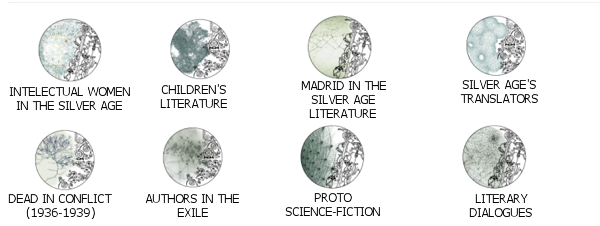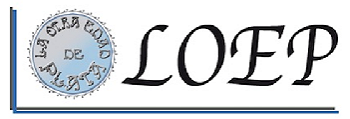MNEMOSINE AND CLAVY: APPLICATIONS FOR THE GESTATION OF SPECIFIC LIBRARIES FOR TEACHING AND RESEARCH
|
Description |
Mnemosine, Digital Library of the Other Silver Age, allows the development of competencies, skills and activities for the reuse of metadata from institutional libraries that facilitate the dynamic reinterpretation of digital history. Mnemosine is managed from the Clavy tool, an RIA that serves to import, maintain and edit information between different repositories, allowing the gestation of collections of enriched digital objects.
Some of the collections of the Mnemosine Digital Library
As reconfigurable tools, Mnemosyne and Clavy are made available to institutions and companies that need specific metadata modeling to generate cross-searches.
|
How does it work |
Mnemosine is an open access digital library that allows the modeling of data from private collections thanks to the Clavy tool. In the generation of the Mnemosyne data model we can distinguish the following phases:
1. - The Data Import Process: the bibliographic information taken from the bibliographic records is taken. Using the logic of connection to MARCXML sources, bibliographic records are imported from, for example, Biblioteca Digital Hispánica or HathiTrust. The Clavy tool supports reconfiguration patterns: sequences of frequently performed editing operations, which can be recovered and reused in new situations.
2.-The Data Adaptation Process: involves collation, cleaning, deletion within the imported data. In this phase, the mapping between the elements of MARC21 and those of the data model defined for Mnemosyne is carried out. It is necessary to develop the specific metadata for the new collection. Clavy allows the inspection of collections through a navigation tree guided by the schemes of the same. The internal support of Clavy is based on an automatic navigation model.
3. - The Data Enrichment Process: the content specialist technician is responsible for nourishing the collections with the specific data of authors and works.
4. - Creation of Collections: Once all this material has been incorporated, the library can be structured into collections: (i) Intellectual women, (ii) Children's literature, (iii) Madrid in the literature, (iv) Translators in the Silver Age, (v) Dead in the conflict, (vi) Authors in exile, (vii) Proto science fiction, (viii) Literary dialogues, (ix) Kiosk literature, and (x) Dead in exile. These highly specialized collections show, therefore, the potential of the proposed model for the creation and preservation of highly specialized collections in Humanities oriented to research or teaching. Likewise, these collections generate doctoral theses, master's degree projects and final degree projects.
5. - Basic Support for Linked Queries: Clavy supports arbitrary boolean queries, which are solved on each of the representations of the navigation automaton. This way in Mnemosine you can perform cross-related searches, for example, with dates, gender, sex and collection.
6. - Export of Collections to External Sources: This functionality is carried out in accordance with an ETL (Extract - Transform - Load) approach, which makes it possible to have a set of import (extract components) and export (load components) generic connectors, addressing the specific aspects in the transformation connectors (transform components).
The Mnemosine data model as a digital library of The Other Silver Age must be extensible, structured, standardized and compatible with the principles of the linked data web. Mnemosine has made the modeling of two stable metadata sheets: Model-Author-File and Model-Worksheet. The purpose is to offer the user encyclopedic records and, therefore, specialized and reliable.
|
Advantages |
The Clavy tool can be very advantageous for both institutional libraries and researchers because it allows:
1. Select specific data for the investigation.
2. Import the data with the Clavy tool to a specialized library.
3. Model metadata with the specific criteria of the investigation.
4. Create specific collections that serve for research and teaching.
5. Incorporate new tools that enrich the collections: @Note, geolocation, visualizations
6. Export metadata to other users or institutions
7. Share enriched metadata with users, groups or institutions.
|
Where has it been developed |
The Mnemosine library has been developed by the LOEP-UCM Research Group using the Clavy digital tool, created by the ILSA-UCM Research Group:
The Research Group The Other Silver Age, Cultural Projection and Digital Legacy (No. 941375) of the Department of Spanish Philology II (Spanish Literature) of the Faculty of Philology of the UCM, created in 2007, is coordinated by Dolores Romero López. We currently have a scientific record of more than 200 works related to this research. The group covers interdisciplinary research lines that are coherent and complementary in the effort to bring to light authors, genres, themes and styles not sufficiently studied about the aforementioned historical period. Its members come from philology, history and librarianship.
The Research Group Implementation of Language-Driven Software and Applications (No. 962022) is an interdisciplinary research group that brings together professors and researchers from various centers and departments of the Complutense University of Madrid (UCM): the School of Informatics ( Software Engineering and Artificial Intelligence, and Computing Systems and Computer Departments), the Arts Schools (Romance Philology, Slavic Philology and General Linguistics Department), and the School of Education Sciences (Department of Didactics and School Organization) . The research interests of the group are: development of software driven by language (ie, software development using techniques taken from the field of design and implementation of programming languages) and development of applications in the fields of digital humanities and e-learning .These applications have been developed with the partial support of two projects funded by the Ministry of Economy and Competitiveness ("Dynamically Reconfigurable Educational Repositories in Humanities: RedR + Human", TIN2014-52010-R, 2015-2017) and by the European Social Fund of the Community of Madrid (eLITE-CM "Electronic Literary Edition (Ref. S2015 / HUM-3426, 2016-2018.)
|
And also |
A challenge of our research is to turn Mnemosine into a smartlibrary that involves innovation and transfer.
|
Contacto |
|
© Oficina de Transferencia de Resultados de Investigación – UCM |
|
PDF Downloads |
|
Clasification |
|
Responsible Researcher |
Dolores Romero López: dromero@filol.ucm.es
Department: Hispanic Literatures and Bibliography
Faculty: Philology





